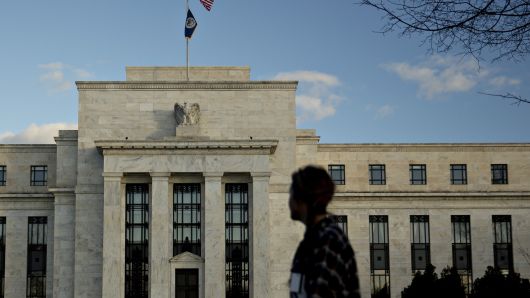

Markets are in a frenzy, the rest of the global economy is slowing down and there are little signs of inflationary pressures building in the system. Everybody knows this is a terrible time for the Federal Reserve to be raising interest rates, right?
Not so fast.
While the number of fists banging on the table to get the Fed to re-examine its current policy arc seems to be growing by the day, central bank officials don’t appear to be listening.
That’s because it’s not the Fed’s job to react every time stocks correct or yields rise or economic forecasts nudge lower. Instead, policymakers are best off to stay resolute in the face of transitory shifts in financial conditions.
Even if deep down they’re just as nervous as everyone else.
“The Fed has to do the opposite of the old adage, ‘walk softly and carry a big stick.’ They have to walk loudly and carry a small stick,” said Gary Pollack, head of the private clients fixed income desk at Deutsche Bank Wealth Management. “They have to portray an image before the financial markets as the adult in the room.”
That’s been a little harder to do lately.
Stocks have been in tumult, weakened by worries over a variety of factors. The S&P 500 was set to open on Friday down more than 9 percent from its record high. A 10 percent decline would put it officially in correction territory.
It all started with hawkish rate talk from Fed Chairman Jerome Powell a few weeks ago, then escalated as the International Monetary Foundation downgraded its outlook for global growth, corporate earnings reports were a mixed bag of higher-than-expected profits and concern about the future, and worries grew about the impact of an escalating global trade war.
None of it has seemed to bother Fed officials.
This week, at least three central bankers delivered speeches that indicated they have no intention on putting a halt on the gradual but steady rate increases that have characterized policy over the past few years. Rather than note the recent wobbles, they’ve each cited a strong economic foundation in the U.S. that justifies further policy normalization off the financial crisis-era extremes.
It’s not that the Fed isn’t paying attention, Pollack said. It’s that officials will stick to the script until the data indicate a different course of action is justified.
‘The Fed has to talk a big game’
Ultimately, he thinks the Fed will not act as aggressively as stated through their current projections. The Federal Open Market Committee in September indicated another rate hike this year, bringing the 2018 total to four, along with three more next year and another hike or two in 2020.
“The Fed has to talk a big game, but they don’t have to play that big game,” Pollack said. “That’s why I don’t think the Fed will raise rates as many times as they have in the summary of economic projections, i.e. the ‘dots.'”
If that’s the case, Powell has plenty of time to redirect policy expectations.
There’s an FOMC meeting in November, where the policy statement could include a nod to tightening financial conditions. Then there’s December, when the committee is expected to raise rates. Powell has a news conference afterward when he again could point to a change, if indeed one is warranted.
What the Fed is less likely to do is to react to momentary shifts in markets, even if it upsets investors.
“By December, the market could be back up again,” said Gus Faucher, chief economist at PNC Financial. “The Fed is looking through any market volatility and saying the underlying economy looks good, therefore it is appropriate for us to continue gradually raising rates.”
Indeed, Fed Vice Chairman Richard Clarida along with regional president Raphael Bostic of Atlanta and Robert Kaplan of Dallas each said this week that more hikes are appropriate. But they also qualified that they will continue to look at the data and will make future decisions based on how the numbers come in.
“It’s more than just the market pulling back. I don’t think that bothers Powell,” said Quincy Krosby, chief market strategist at Prudential Financial. “But if the economic data weaken, that’s going to matter for them.”
Expectations for a December rate hike have cooled somewhat in recent days, with December down to a 73.6 percent chance, which is still high. Expectations in 2019 are another matter, with March at a shade less than 50-50. Fed funds futures contracts imply a rate of 2.82 percent by the end of 2019, more than a full hike behind the Fed’s current projection of 3.1 percent. The current target range is 2 percent to 2.25 percent.
Markets staged an aggressive rebound Thursday, highlighting another dilemma for the Fed: If it hikes too quickly it risks halting what has been an otherwise robust showing that began in 2017, and if waits too long inflation could become a problem and force emergency tightening measures.
Fed officials have contemplated the balance openly, and at least for now are titled more toward getting ahead of inflation.
“Jerome Powell has been been clear that he wants to engineer a soft landing, which would be first,” Krosby said. “I don’t think this team at the Fed, which is very experienced, wants to be known for leading the U.S. into a recession.”